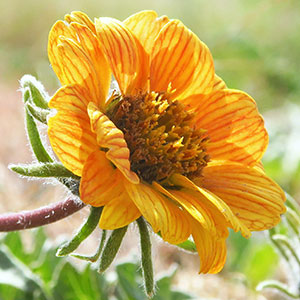Balsamorhiza rosea
Balsamorhiza macrophylla
rosy balsamroot
cutleaf balsamroot, Idaho balsamroot, large-leaf balsamroot
blades gray-green, oblong to lance-ovate, 3–10(–20) × 2–5 cm (rarely pinnately lobed), bases weakly cordate or truncate, margins crenate to serrate, apices rounded to acute, faces finely strigose to moderately scabrous (usually gland-dotted as well).
green, ovate to lanceolate, 20–50+ × 8–15 cm (pinnatifid, lobes lanceolate, 20–80+ × 10–40 mm, entire or ± dentate), bases ± cuneate, ultimate margins usually entire (plane or weakly revolute, ciliate), apices obtuse to acute, faces scabrous or piloso-hirtellous to pilose (at least abaxial usually gland-dotted as well).
hemispheric, 18–20 mm diam.
± hemispheric, 20–30 mm diam.
(becoming brick-red, often drying to pink or rose, and chartaceous) (8–)15(–25) mm (hispidulous abaxially; cypselae strigose).
35–50+ mm.
deltate or ovate to lanceolate, 8–12 mm, not surpassing inner.
lance-ovate or lanceolate to lance-linear, 12–30(–40) mm, equaling or surpassing inner (margins ciliate), apices acute to attenuate.
usually borne singly.
usually borne singly.
= 38.
= 100 ± 2.
Balsamorhiza rosea
Balsamorhiza macrophylla
In a hybrid swarm involving Balsamorhiza rosea and B. careyana, B. rosea remains relatively uncontaminated; the dominance among the hybrids appears to lie with B. careyana. A record of a hybrid between B. rosea and B. careyana from the Spokane area is doubtful.
(Discussion copyrighted by Flora of North America; reprinted with permission.)
Balsamorhiza macrophylla is a high polyploid; it occurs sympatrically with B. sagittata. It evidently arose from hybridization between B. sagittata and B. hispidula. Balsamorhiza macrophylla has the multi-branched caudices and massive taproots of the former, and the leaf dissection of the latter. No hybrids with other species are known. Presumably, the high-polyploid chromosome complement precludes interbreeding. Plants of var. idahoensis are smaller, are known only from southwestern Idaho and northeastern Utah, and differ from var. macrophylla by being pilose, with strongly shaggy-pilose involucres. More study may determine that var. idahoensis merits specific rank. The Utah populations are not well understood and deserve attention.
(Discussion copyrighted by Flora of North America; reprinted with permission.)


